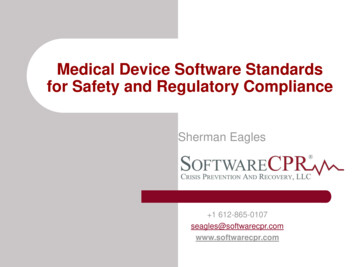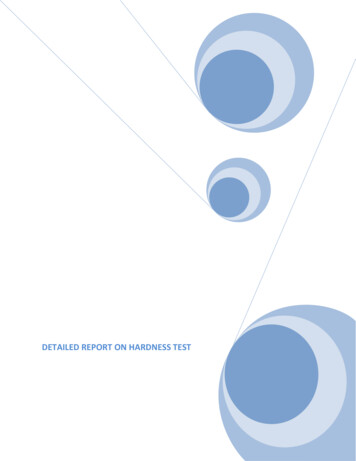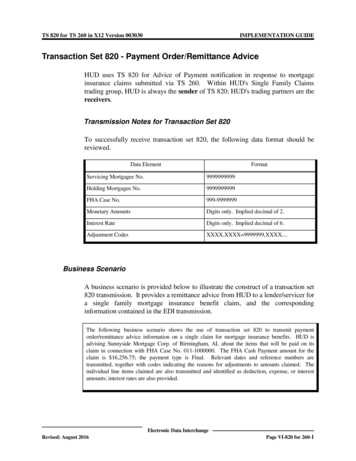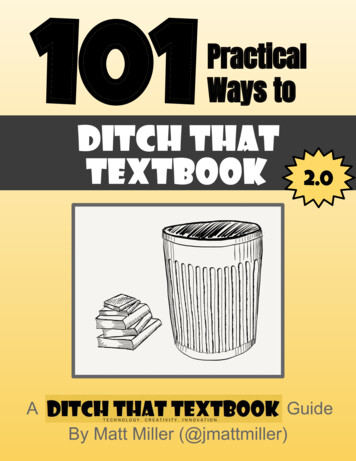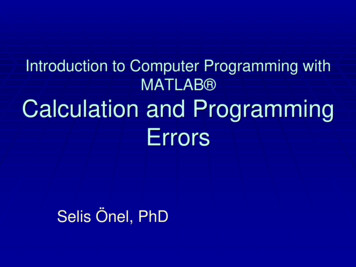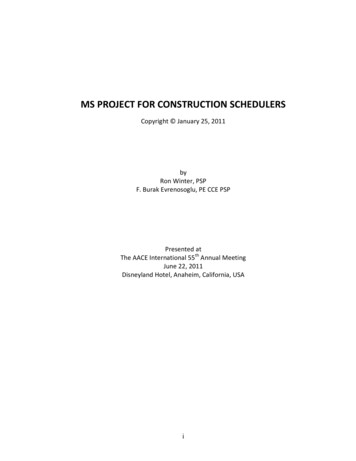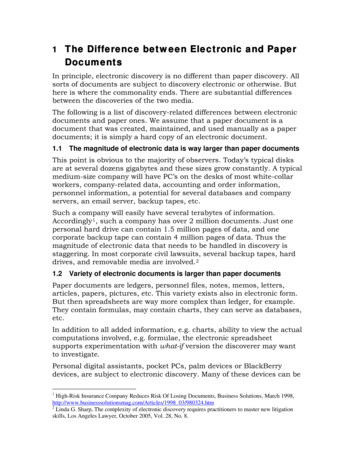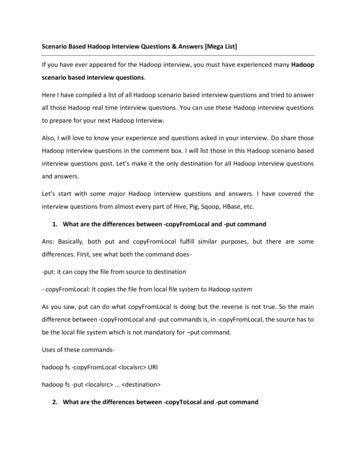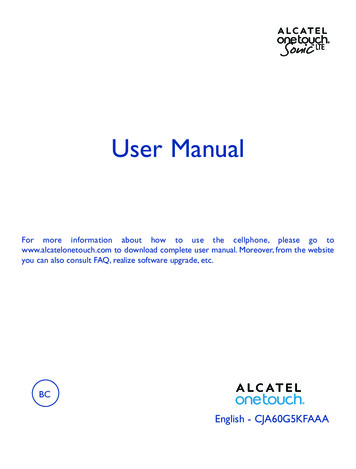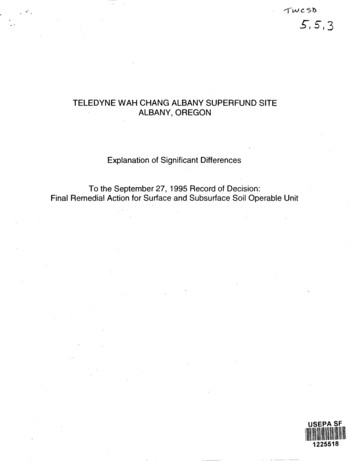
Transcription
TELEDYNE WAH CHANG ALBANY SUPERFUND SITEALBANY, OREGONExplanation of Significant DifferencesTo the September 27, 1995 Record of Decision:Final Remedial Action for Surface and Subsurface Soil Operable Unit
TELEDYNE WAH CHANG ALBANY SUPERFUND SITEALBANY. OREGONEXPLANATION OF SIGNIFICANT DIFFERENCESTo the September 27, 1995 Record of Decision: Final Remedial ActionFor Surface and Subsurface Soil Operable Unit1INTRODUCTION1.1Site Name and LocationTeledyne Wah Chang AlbanyMillersburg, Oregon1.2Lead and Support AgenciesThe Environmental Protection Agency (EPA) is the Lead agency on this site. TheOregon Department of Environmental Quality (ODEQ) is the Support Agency onthis site.1.3Explanation of Significant DifferenceThis document addresses significant changes to the ROD for Final Remedial Actionfor Surface and Subsurface Soil Operable Unit, Teledyne Wah Chang AlbanySuperfund Site, September 27, 1995 (Soil ROD). This document provides anExplanation of Significant Differences as required under Section 117c of CERCLA,and the National Contingency Plan (NCP) 40 C.F.R. §300.435(c)(2)(l). Thesechanges to the ROD requirements are based on the newly available informationgained from soil excavation during the first phase of the Remedial Action. Thechanges are significant, but not fundamental changes to the remedy.1.4Circumstances Leading to the Changes to the Excavation of GammaEmitting Material Remedy in the RODThe areal extent of buried gamma emitting material (GEM) significantly differs fromwhat was estimated through RI/FS characterization of the site. In addition todiffering conditions in the Sand Unloading Area and Front Parking Lot Area,information received from Wah Chang since the ROD and remedial action for soilindicates that other areas of the site also contain GEM.Teledyne Wah Chang Albany Superfund Site,Explanation of Significant Differences, September 2001Page 1
Based on investigation collected during the RI/FS, the ROD estimated that 835cubic feet of material would need to be excavated in the Sand Unloading Area.Actual excavation was 1890 cubic feet, however, a significant volume of GEMextending beneath existing structures was not removed during the Sand UnloadingArea excavation.In the ROD, it was estimated that 2268 cubic feet of GEM would need to beexcavated in the Front Parking Lot Area. Actual excavation in the Front Parking Lotwas 8100 cubic feet. In addition, the areal extent of GEM with gamma emissionsbelow the cleanup level that is being left in place is greater than the RODestimates.1.5Circumstances Leading to the Changes to the Institutional Controls forRadon in the Soil Amendment Area Remedy in the RODThe ROD called for the implementation of institutional controls requiring futurebuildings to be constructed using radon resistant construction methods. In order toensure that there is a viable remedy should institutional controls not beimplementable, EPA is modifying the remedy for the Soil Amendment Area toinclude more protective options.1.6Administrative RecordThis Explanation of Significant Differences will become part of the AdministrativeRecord File for the site. The record is available in the EPA Region 10 RecordsCenter located at 1200 6th Avenue, Seattle, Washington.A notice of the ESD will be placed in the Albany Herald.2SITE BACKGROUNDThe Teledyne Wah Chang Albany site is located in Miltersburg, Oregon, adjacent tothe city of Albany. The facility covers approximately 225 acres and is located nearthe Willamette River. Since site listing, Teledyne Wah Chang has changed itsname to Wah Chang (WC). Thus the Superfund site is called Teledyne WahChang Albany, but the facility is called Wah Chang. The Wah Chang facility isdivided into a 110-acre main plant area and a 115-acre Farm Ponds area (seeFigures 1, 2, and 3 for site maps and locations of areas covered in this ESD).Wah Chang is an active operating facility which primarily manufactures zirconiumand other specialty metals. The manufacturing operation consists of numerousproduction facilities used for the extraction and refining of zirconium and hafniummetals from zircon sands, with a small amount of tantalum, columbium, titaniumand vanadium metals also being produced. The plant also has a number of wasteTeledyne Wah Chang Albany Superfund Site,Explanation of Significant Differences. September 2001Page 2
E09200IOOrCVO I539HCCPM Lpolcn ttp Tij 01 tif 09CT01 mtt.TT-T-T Trir% FARM PONDS1 ItKIN PLANTARfeA'." -'. ':,- *f.-i ' '-! :: ' '.Source: USGS 1:24.000 Albany. Oregon0100020003000SCALE40005000 fEETFigure 1Location MapTeledyne Wah Chang AlbanyAlbany, OregonCH2MHILL
COOLINGWATER POND-M 'lV.- TRUAX CREEK) */ !'I" -L L JLEGENDSTREAM BOUNDARYTOPOGRAPHICALLINEDIRT ROADEXISTING FENCEFIGURE 2SITE MAPWAH CHANGALBANY. OREGON01 -ew-2001uiowAAP(iOA*' MOw«:\cD'cm\pu\puroo«.owc.CH2MHILL
SCALE IN FEET0200400LEGENDSTREAM BOUNDARY— lie—1 TOPOGRAPHICAL LINE.«.—"DIRT ROADEXISTING FENCEFIGURE 3FRONT PARKING LOT ANDFORMER SAND UNLOADINGAREA LOCATIONSWAH CHANGALBANY. OREGONn-Ocl-2001UIDWAY%PROJ\w«HCHA«C\CDtCU \PU\PUFD05.0WCCH2MHILL
treatment and storage facilities and several on-site ponds that were, or presentlyare, being used for the storage and treatment of liquids and solids.The processing of the zircon sands generates solid, liquid, and gaseous by products. Contaminants of concern detected in waste by-products includeradionuclides, metals, polychlorinated biphenyls (PCBs), methyl isobutyl ketone(MIBK), and chlorinated organic solvents such as 1,1,1-trichloroethane andtetrachloroethylene.Under an ODEQ permit, some of the wastewater treatment sludge generated byWah Chang prior to 1976 was used as a beneficial soil amendment on agriculturalland in an area now identified as the Soil Amendment Area, part of the 115-acreFarm Ponds Area. This sludge contained low levels of radium-226, a constituentwhich breaks down naturally to form radon gas. In open, uncovered areas, radonrapidly dissipates and breaks down in the atmosphere. However, without adequatecontrols, in buildings underlain by soil containing radium-226, radon mayaccumulate to levels that are not protective.Wah Chang is regulated by the Oregon Health Division (OHD) under an OregonRadioactive Material License (Broad Scope Naturally Occurring RadioactiveMaterial (NORM) License). The NORM license covers handling and disposition ofradioactive materials under current operations as well as at plant decommissioning.Decommissioning (i.e., safe appropriate disposition of all radioactive material undersupervision of OHD and in accordance with applicable requirements) must occurwhenever Wah Chang ceases operations or closes the site.3PROGRESS ON THE REMEDIAL ACTION FOR SOIL3.1Soil RODThe Record of Decision for Final Remedial Action for Surface andSubsurface Soil, September 27,1995 called for the following actions:Excavation of material exceeding the gamma radiation action level of20 jrem/hour above background, measured at one meter above thesurface and averaged over 100 square meters (40 CFR 192.12).Transportation of excavated material to an appropriate offsite facilityfor disposal.For areas of the site where modeling indicates that radonconcentrations in future buildings could exceed 4 pCi/liter, implementinstitutional controls requiring that future buildings be constructedusing radon resistant construction methods.Teledyne Wah Chang Albany Supertund Site,Explanation of Significant Differences, September 2001Page 6
Information on areas of subsurface PCB and radionuclidecontamination that do not pose a risk if they are not disturbed will beincorporated into the Wah Chang facilities maintenance plan. Thisinformation will be made available to future site purchasers orregulatory agencies.The determination that action is not required for certain areas of thesite is based on scenarios that do not allow unrestricted use. Properhandling and disposal of excavated material in accordance withfederal and state laws are required should excavation occur as part offuture development of the Wah Chang main plant or the soilamendment area.3.2Remedial Action for Soil3.2.1 Schmidt LakeOn August 26, 1998, Wah Chang excavated between 12 and 15 cubicyards of soil from Schmidt Lake. All areas exceeding the site actionlevel of 20 urem/hour above background were excavated.3.2.2 Sand Unloading AreaThe RI/FS identified a relatively small area where surface gammaradiation levels exceeded the cleanup standard of 20 urem/hourabove background. The elevated gamma radiation levels in the areawere expected to be emanating from spilled zircon sands (rawmaterials for the zirconium process) containing a naturally occurringradium-226 component. The underlying assumption for the selectionof the excavation remedy was that the RI/FS identified the locationand extent of all on-site areas where surface and near surface GEMwas present. As described below, during the excavation of this area,it was determined that although sand was present on the groundsurface, it was not the primary source for all of the gamma emissions.The remedial action was conducted in October 1997. Excavation wasstopped when the northwestern edge of the material appeared toextend beneath a concrete slab in front of the mobile maintenanceshop, and under the shop itself, and when the northernmost end ofexcavation would have interfered with on-site traffic with no evidencethat the limit of contamination had been reached. In the areasexcavated, GEM was found within 2 feet of the surface. Aconfirmation surface gamma survey showed that within the excavatedarea, levels were below the cleanup standard of 20 urem/hour abovebackground. The amount excavated was 1890 cubic feet, twice theROD estimate.Teledyne Wah Chang Albany Supertund Site,Explanation ol Significant Differences. September 2001Page 7
While some of the gamma emissions in the area resulted from spilledsands on the ground surface, there was a significant quantity of buriedmaterial. Four primary types of material were identified in theexcavation area: black sand, reddish brown sand, green sand andgray materials containing rock like "clinkers" (a waste from the formercarbide process emitting significantly elevated levels of gammaradiation).A subsequent review by Wah Chang of gamma survey andradionuclide sampling information, collected during past excavationprojects in the vicinity of the Sand Unloading Area, was done in anattempt to determine the areal extent of contamination. Radionuclidecontaminated material, which could exceed cleanup levels ifuncovered, was found 200 feet to the north, 200 feet to the northeast,and 200 feet to the east of the area. The material found wasidentified as carbide waste, a process waste with a high radium-226concentration, that had previously been disposed on the site.Most of the Sand Unloading Area is now overlain by Wah Chang'snew co-generation (COGen) Plant, a natural gas, electric generatingplant. The plant is built on a 14" concrete slab, which presents an-effective gamma blocking barrier (see Figure 4).3.2.3 Front Parking Lot AreaBlack sand, a low level radioactive rutile sand (natural mineral form ofTitanium Dioxide) was identified for removal in the RI/FS, and wasremoved during the soil remedial action. A 1 to 6 inch layer of blacksand was identified 6 to 12 inches below the Front Parking Lot'sgravel surface. The layer of black sand covered native soil. Althoughthe areas where surface gamma readings exceeded the cleanup levelwere excavated, visual observations and anecdotal evidence suggestthat the entire Front Parking Lot is underlain by this material exceptwhere it was excavated for the Building S-147 concrete foundation.Samples of the sand indicate that radium-226 levels could causeradon concentrations in future buildings to exceed the radium-226action level of 4 pCi/liter set in the ROD. If the thickness of the sandwere changed (i.e., if it were consolidated) the material could exceedthe cleanup standard of 20 urem/hour above background.3.2.4 Soil Amendment AreaThe institutional controls in the soil amendment area have as yet notbeen implemented.Teledyne Wah Chang Albany Supertund Site,Explanation of Significant Differences. September 2001Page 8
LIMITS orEXCAVAIION ON-GRAOF.CONCRETESLAGMOBILEMAINTENANCESHOPFORMER SANDUNLOADING AREALEGEN&.15N7.5NGAMMA RADIATION SURVEYGRID COORDINATES (FEET)AND GAMMA MEASUREMENTS(orem/hr)Figure 4CoGen Building FootpringRelative to Former Sand Unloading Are
4CHANGES TO THE SURFACE AND SUBSURFACE SOIL ROD4.1Changes to the Remedy for SoilThis ESD outlines the final CERCLA remedy for this site for surface and subsurfacesoil. Based on current information, no additional cleanup action for radionuclidesunder CERCLA is anticipated.EPA is making the changes listed below to the soil remedy. Additional informationand justifications for these changes are provided in subsequent subsections.4.1.1 Change #1: Final site closure for radionuclides will be conductedpursuant to Wah Chang's Oregon Radioactive Materials License(Broad Scope Naturally Occurring Radioactive Material License) andthe Oregon Facility Siting Council (EFSC) Administrative Rules(Chapter 345, Division 50).4.1.2 Change #2: On-site surface gamma emissions will be controlledthrough in-place management of contamination. Prior to sitedecommissioning under OHD and EFSC, surface gamma emissionsmust be kept below cleanup levels through in-place managementunder an EPA and ODEQ approved management plan, and additionalexcavation of contamination performed as part of ongoing excavationoccurring during onsite construction.4.1.3 Change #3: If the site is not decommissioned under OHD and EFSCto EPA's cleanup requirements, radiation management shall be acondition of property transfer to ensure that these controls remainprotective. Any partial or complete property transfer shall beconditioned on implementation and maintenance of an appropriateEPA/ODEQ approved radiation management program.4.1.44.2Change #4: Excavation and either berming or offsite disposal is anacceptable remedy for the Soil Amendment Area if institutional controlscannot be implemented.Change #1: Final site.closure for radionuclides will be conducted pursuant toWah Chang's Oregon Radioactive Materials License (Broad Scope NaturallyOccurring Radioactive Material License) and the Oregon Facility SitingCouncil (EFSC) Administrative Rules (Chapter 345. Division 50).EPA and ODEQ will coordinate with OHD during decommissioning to ensure that thecleanup will meet EPA requirements to the greatest extent practicable. Followingdecommissioning, EPA and ODEQ will evaluate whether the cleanup is protective ofpublic health and the environment.Teledyne Wah Chang Albany Supertund Site,Explanation ot Significant Differences, September 2001Page 10
4.2.1 ROD RequirementExcavation of material exceeding the gamma radiation action level of20 (jrem/hour above background, measured at one meter above thesurface and averaged over 100 square meters (40 CFR 192.12).4.2.2 Explanation of Change #1This change applies to the entire main plant. Areas delineated in theROD for excavation of buried GEM have been excavated. GEM is stillpresent on the site in currently known, suspected, and potentiallyunknown areas. Much of this material is inaccessible for excavationwithout removal of current site structures and buildings. OHD andEFSC have jurisdiction over the decommissioning (cleanup) of theplant for radionuclides. Following decommissioning, EPA and ODEQwill determine whether the cleanup meets the CERCLA risk-basedcleanup requirements for an industrial site.Recent EPA guidance reaffirms that NORM site closure under Licenserequirements may satisfy CERCLA risk-based remediationrequirements. (See OSWER No. 9272.0-15P, Interim Final Evaluationof Facilities Currently or Previously Licensed NRC Sites underCERCLA, Timothy Fields, Jr. Assistant Administrator.) The CERCLAremedy does not contemplate excavation of additional radioactivematerial from the site beyond what has already been remediated, whatwill be removed per the provisions of this ESD, (see Section 4.5.4).and what will be removed when the site is decommissioned.The cleanup standard for radionuclides is modified in this ESD to thefollowing standards.4.2.2.1Excavation Cleanup StandardWhen excavation occurs for any reason, within the areaof excavation, prior to covering or backfilling, gammaemissions from the remaining radionuclide containingmaterial must not exceed 20 urem/hour abovebackground, measured at one meter above the surface.This standard is applied as the average over 100 squaremeters or the area of the excavation, whichever issmaller. The 100 square meter averaging area in theROD was based on a large excavation area. Theaveraging size is modified in this ESD to take intoaccount future excavations that could be less than 100square meters.Teledyne Wah Chang Albany Supertund Site,Explanation of Slgnltlcant Differences. September 2001Page 11
4.2.2.2Plant Wide Cleanup StandardThroughout the site, surface emissions from GEMmanaged in place must not exceed 20 (jrem/hour abovebackground, measured at one meter above the surface.This standard is applied as the average over 100 squaremeters.4.2.2.3Radium-226 Action Level to Prevent Unacceptable Riskfrom Radon InhalationEPA is providing the following clarification for theselected radium-226 and radon action levels.EPA's policy provides that when a site action level isexceeded, the usually acceptable cleanup goal is withinthe 10'4 to 10"6 excess cancer risk range. EPA strives toselect remedies at the more conservative end of thisrange. However, for risks from naturally occurringradionuclides, EPA generally selects remedies in theupper end of the range, because of the practicallimitations in distinguishing small excess risks from therisks due to natural background radionuclideconcentrations. For this site, EPA has selected thecleanup goal for radon in future buildings to be an excesscancer risk which does not exceed 1x10"4.The radium-226 action level for protection from radonremains the same as in the ROD. The action level forradium-226 assumes that action will be taken whenradon concentrations in buildings could exceed 4pCi/liter. This concentration includes the radoncomponent contributed from background radium-226levels. At this concentration, excess cancer risk fromradon above background levels is approximately 6x10"4for the exposure conditions assumed. Modelingperformed during the RI/FS in the 1995 RadiologicalSurvey indicates that radon concentrations insidestructures constructed without radon controls and placedon soil with radium-226 concentrations above 3pCi/gram, could exceed 4 pCi/liter. Thus, the radium-226action level is 3 pCi/gram.Teledyne Wah Chang Albany Supertund Site.Explanation of Significant Differences, September 2001Page 1 2
EPA selected a technology-based cleanup requirement forradon control, rather than specifying a cleanup level thatmust be obtained. This is consistent with EPA's currentRadon Program requirements. EPA is requiring that futurebuildings be constructed using radon resistant constructionto protect against the potential for the radon action level tobe exceeded within such structures. When the systems inthe buildings are operated, radon concentrations should bebelow the radon cleanup goal of risk from radon not toexceed an excess cancer risk of 1x10 4. The purpose ofrequiring continued maintenance and operation of suchsystems in the buildings is to ensure that concentrations willcontinue to be below the radon cleanup goal.These radon controls require that the air within buildingsmust be periodically tested for radon. As required in theROD, if radon concentrations exceed the EPArecommended radon action level or promulgated standard ineffect at the time of these sampling events, additionalcontrols will be required to reduce radon concentrationsbelow the EPA recommended action level or promulgatedstandard. Because the current recommended action level of4 pCi/liter is technology based, the ROD and this ESD donot "freeze" the requirement (see Section 10.2 in the ROD).4.2.2.4Final Cleanup Requirements for the Wah Chang Main PlantThe current cleanup standards for chemicals andradionuclides in soil are based on industrial standards.Therefore, site use must always be restricted to industrialuse. Standards for GEM are therefore based on anindustrial site use scenario. The requirements of this ESDfor will remain in place unless cleanup meets the followingstandards:Onsite GEM must be either excavated and disposed offsite,permanently capped, or a combination of both options.During excavation, GEM must be excavated to a levelwhere, .without capping or overburden, the surface gammaemissions would be below EPA risk-based levels and/orpromulgated standards in place at the time cleanup occurs.The current standard for this site is 20 urem/hour abovebackground. Excavated material must be disposed of at anEPA and ODEQ approved facility.Teledyne Wah Chang Albany Supertund Site,Explanation ot Significant Differences. September 2001Page 13
The remaining GEM must not exceed concentrations whichwould result in indoor radon concentrations exceeding theEPA recommended action level, or risk-based levels and/orpromulgated standards in place at the time cleanup occursIf capping is selected, the cap must be a RCRA-compliant,permanent cap. Institutional controls must then be placedon the property to permanently protect the cap. Operationand maintenance of the cap will be required. Buildingrestrictions for radon may be needed if the cap does notprovide some means for venting radon.4.2.2.5Post Decommissioning ActionsIf decommissioning occurs and/or land use assumptionschange, any new requirements or issues related to thesechanges will be addressed at that time or under the 5-yearreview.As described under Change #2, until site closure, anappropriate radiation management program must be inplace that ensures that surface gamma emissionsthroughout the site do not exceed 20 prem/hour abovebackground averaged over 100 square meters or the areaof the excavation, whichever is smaller. This requirementapplies to areas of disposed GEM. It does not apply tomeasurements from materials which are part of the currentor future Wan Chang industrial processes, i.e., those in"Mem Tech" where by-product material with a radionuclidecomponent is processed for disposal at an off-site landfill.4,2.3 Basis for Change #1The remedy selected by EPA in the ROD was designed to be the finalremedy for buried radioactive material at the site. However, as describedbelow, new information revealed that the extent of buried material wasgreater than was characterized in the RI/FS, and it is not feasible toadequately excavate the site while Wah Chang is still in operation.During excavation of the Sand Unloading Area and the Front Parking LotArea in the first phase of the Remedial Action, GEM volumes, arealextent, and magnitude of gamma emissions exceeded the estimatesbased on site characterization in the RI/FS. The original remedy in theROD was based on information that areas of surface and near surfaceradionuclide contamination were delineated by the surface gammaTeledyne Wah Chang Albany Supertund Site,Explanation of Significant Differences. September 2001Page 14
survey performed during the RI/FS, and that the magnitude of gammaemissions from the material in the delineated areas was relatively low(i.e., less than an order of magnitude above the cleanup standard basedon a high reading in the Sand Unloading Area of approximately 80urem/hour.) The two areas with differing conditions from the ROD aredescribed below.Sand Unloading AreaThe selected excavation remedy was premised on the informationavailable at the time that there was a finite amount of spilledprocess sand in the area. The sand is a material from whichzirconium was extracted. This sand has a naturally occurringradium-226 component that accounted for the elevated gammareadings.In the Sand Unloading Area, approximately 6 inches to 1 foot ofclean overburden effectively shielded underlying GEM so thatsurface gamma radiation measurements in the area were within afew urem/hour of background levels. However, during the firstphase of the remedial action, it was discovered that, beneath theoverburden, the underlying material consisted of red sand, greensand and a grey black material identified as carbide waste orclinkers. This material is a process by-product which, in the SandUnloading Area, had a gamma reading above 500 urem/hourmeasured at 1 meter above ground surface (much greater thanthe 80 urem/hour measured in the RI/FS).Excavation work in this area was stopped when the excavationreached the middle of a roadway, and the edge of the concreteslab of the Mobile Maintenance Shop. It became apparent thatthe areal extent of radionuclide contamination greatly exceededthe discrete area assumed during remedy selection.Information subsequently provided by Wah Chang summarizingpast site excavation activities, showed that carbide waste may belocated within a much larger area, approximately 200 feet in allproperty directions from the area slated for remediation.Front Parking Lot AreaThe excavation remedy in the ROD was based on informationindicating that there was a limited area in the Front Parking Lotwhere rutile sand (titanium dioxide with a naturally occurring, verylow radium-226 component) were placed. However, newTeledyne Wah Chang Albany Super-fund Site,Explanation ot Significant Differences. September 2001Page 1 5
information provided by Wah Chang indicates the Front ParkingLot is completely underlain with rutile sand. The gamma emissionlevel of this sand without overburden is minimally above cleanuplevels or below them, based on the extent and thickness of thesand. In the Front Parking lot area, all areas above the action levelfor gamma emissions have been excavated.Following excavation, radium-226 concentrations in the stockpilesof excavated material were measured at 3 to 4 pCi/g radium-226.One confirmation sample of material in place following excavationwas reported at 5.8 pCi/g radium-226. These measurementsindicate that indoor measurements for radon in any futurebuildings constructed in this area could exceed the ROD radonstandard of 4 pCi/liter.Based on the information provided by Wah Chang, GEM may alsobe present in other areas of the site as well, namely "Truax Fill"and "Arrowhead Lake" fill areas. The Truax Fill area wasstabilized during the Truax Creek remediation. Arrowhead Lake ispartially covered by a building. These areas are currentlycontrolled in place, but need to be addressed duringdecommissioning.Removal of the GEM remaining on the site is not feasible whileWah Chang is in operation. Removal would involve potentiallydestroying onsite buildings, and would disrupt and probably haltWah Chang plant operations. The existing structures themselvesnow provide an adequate level of shielding from the GEMpotentially present underneath them.Potential exposure to GEM may result when structures are razed,or if Wah Chang conducts excavations (or experiences someother event such as an earthquake) that bring the subsurfacematerial closer to the surface, or when the Wah Chang plantcloses. The changes identified in this ESD are designed to ensureprotectiveness under these circumstances.4.3Change # 2: Control of site surface gamma emissions through in-placemanagement of contamination4.3.1 ROD RequirementExcavation of material exceeding the gamma radiation action level of20 (jrem/hour above background, measured at one meter above thesurface and averaged over 100 square meters (40CFR192.12).Teledyne Wah Chang Albany Supertund Site.Explanation of Significant Differences, September 2001Page 16
4.3.2 Explanation of Change #2Areas demarcated in the ROD have been excavated. These changes tothe remedy apply to those areas throughout the main plant where GEMremains in place including areas currently known, areas of GEM that maybe currently unknown, and areas where future excavations, or otherevents, uncover GEM.Areas where surface gamma emissions are detected above the RODaction levels shall be excavated or capped so that the levels are belowthe cleanup standard of 20 urem/hour. Capping requirements aredescribed below.Most areas of the plant are currently overlain (capped) with asphalt,concrete or compacted fill. These materials are effective at limitinggamma emissions and must be inspected and maintained to ensure theireffectiveness. In place management must continue until the material isremoved and/or EPA determines that in place management is no longerrequired because the site meets EPA risk-based cleanup standards.Areas where it is known that GEM is disposed, but where surfaceemissions do not exceed cleanup levels need to be monitored every twoyears, or when the areas are disturbed to ensure that surface gammaemissions remain below the cleanup levels. If these levels areexceeded, capping or excavation will be required.Areas where in-place management is occurring shall be demarcated asdescribed in the Record Keeping Requirements below.This change to the remedy is an outgrowth of the remedy selectionprocess in the Rl/FS. In the Radiological Survey (Addendum 1 to theRI/FS, CH2M Hill 1995) two viable alternatives were presented forremediation; an excavation option where the material was excavated anddisposed of offsite; and a capping option. The capping option called forasphaltic concrete in sufficient lift thickness to attenuate the surfacegamma emissions. The ROD selected an excavation remedy because,for the conditions assumed at the time of remedy selection, excavationmet ARARs, was more permanent, and was more cost effective.In both the Sand Unloading Area and the Front Parking Lot, the areaswhich were demarcated in the ROD as having surface gamma emissionlevels exceeding the ROD criteria of 20 urem/hour above b
for Surfac ane d Subsurface Soil Operable Unit, Teledyn Wahe Chang Albany Superfund Site, Septembe 27r , 199 5 (Soil ROD). This document provide an s Explanation of Significant Difference as requires d under Section 117 of CERCLAc , and the National
